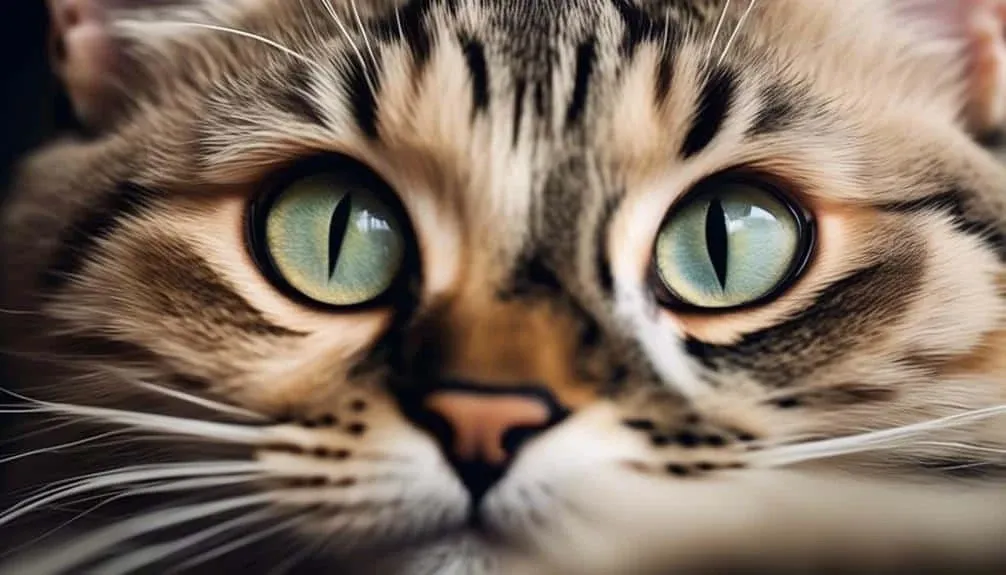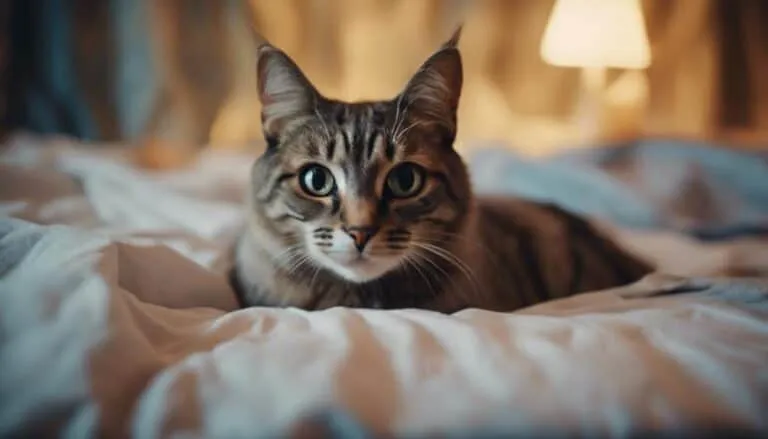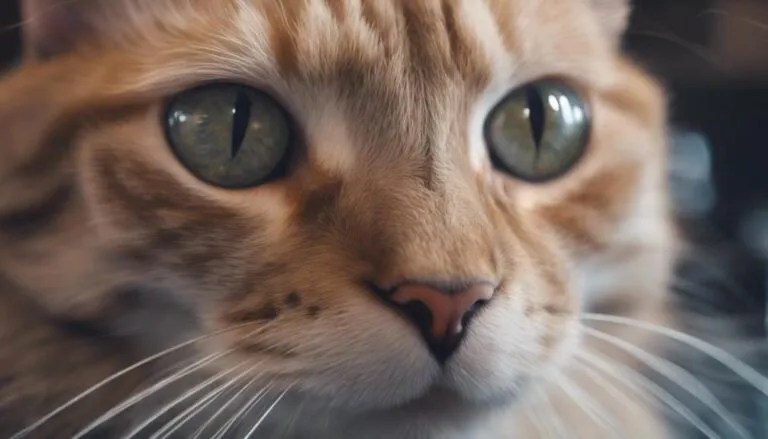The Best Fluffy Pancakes recipe you will fall in love with. Full of tips and tricks to help you make the best pancakes.

Like a window into their mysterious inner world, a cat's blink holds untold secrets waiting to be discovered. Have you ever wondered what lies behind that seemingly simple act of closing and opening their eyes?
In this exploration, you will uncover the hidden depths of a cat's blink, unraveling the intricate anatomy of their eyes and delving into the enigmatic behavior that surrounds it.
Prepare to be captivated as we unveil the fascinating world of feline vision and unlock the secrets behind their mesmerizing blinks.
Key Takeaways
- Cats have a unique composition of photoreceptor cells and a wider field of vision compared to humans.
- The third eyelid, or nictitating membrane, acts as a windshield wiper for a cat's eye, keeping it clean and protected from irritants.
- Humans also have a vestigial third eyelid, which serves no purpose but is still present in our bodies.
- Cat blinking behavior, characterized by the use of the nictitating membrane, is influenced by instincts, communication, and can indicate trust and relaxation.
Understanding Cat Vision
To comprehend the intricacies of a cat's vision, it's essential to understand the unique composition of their photoreceptor cells and the wider field of vision they possess compared to humans.
Cats have a remarkable visual system that's adapted to their hunting instincts. The anatomy of a cat's eye plays a crucial role in their visual perception. The photoreceptor cells in a cat's eye, known as rods and cones, are arranged differently than in humans. This allows them to see better in low light conditions and detect movement with incredible precision.
Additionally, cats have a wider field of vision, reaching up to 200 degrees, compared to our 180 degrees. This broader perspective enables them to detect prey or potential threats more easily.
Understanding these differences in cat eye anatomy and visual perception helps us appreciate the unique way cats see the world around them.
The Function of the Third Eyelid
The unique anatomy of a cat's eye extends beyond their exceptional vision, as their third eyelid, also known as the nictitating membrane, plays a crucial role in their ocular health and protection. The tear ducts in a cat's eye are responsible for keeping their eyes moist, while the nictitating membrane acts as a windshield wiper, clearing the eye of dust and debris.
The importance of tear ducts and the role of the nictitating membrane in eye health can't be understated. Here are three key reasons why the third eyelid is vital for a cat's well-being:
- Protection: The nictitating membrane acts as a physical barrier, shielding the cat's eye from irritants and potential damage.
- Moisture: By moistening the eye, the third eyelid helps prevent dryness and keeps the eye lubricated.
- Cleansing: The nictitating membrane allows cats to keep their eyes clean without the need to fully close their eyelids, ensuring optimal visibility and comfort.
Understanding the function of the third eyelid highlights the importance of maintaining a cat's ocular health and underscores the role of tear ducts and the nictitating membrane in safeguarding their eyes.
Comparison to Human Eyes
Cats and humans have distinct differences in their eye anatomy and functionality. While cats have a third eyelid, also known as the nictitating membrane, humans possess a vestigial third eyelid that no longer serves a purpose.
This difference in eye anatomy is just one of the many disparities between our eyes. Humans have a more complex eye structure, with a larger central fovea, allowing for greater visual acuity. In contrast, cats have a tapetum lucidum, a reflective layer in the back of their eyes that enhances their night vision.
Additionally, cats have a wider field of vision than humans, thanks to their larger corneas and pupils. Understanding these differences in eye anatomy is crucial for providing appropriate care and treatment for both cats and humans.
Cat Blinking Behavior
Cat blinking behavior is a fascinating and intricate aspect of feline communication and eye health. Understanding the frequency of cat blinking and the factors that affect it can provide insight into a cat's well-being and emotions. Here are some key points to consider:
- Cat Blinking Frequency:
- Cats rarely blink by fully closing their eyelids like humans.
- Instead, they rely on their nictitating membrane, or third eyelid, to keep their eyes clean and protected.
- The use of the third eyelid makes it difficult to determine the exact frequency of cat blinking.
- Factors Affecting Cat Blinking:
- Environmental conditions, such as wind or dirt, may cause cats to blink more frequently to keep their eyes clean.
- Cats also use blinking as a way to communicate love, trust, and affection.
- Slow, soft blinking from a cat indicates that they feel safe and comfortable with the person they're blinking at.
Understanding cat blinking behavior can help foster stronger bonds with our feline companions and ensure their eye health is properly maintained.
The Meaning Behind Cat Blinking
Blinking behavior in felines carries significant meaning and can provide valuable insights into their emotions and communication methods. Cat body language is a complex system of nonverbal cues that cats use to express themselves. Blinking is one such behavior that holds deeper significance.
When a cat blinks slowly, it's a gesture of trust and affection. It indicates that the cat feels safe and comfortable in your presence. By reciprocating with a slow blink, you can communicate your own trust and affection back to the cat. This form of communication helps to build a bond and establish a sense of security between you and your feline companion.
Understanding the meaning behind cat blinking allows us to better interpret their emotions and strengthen our relationship with them.
Observing and Interpreting Cat Blinking
When studying the intricate behavior of felines, it's essential to closely observe and interpret their blinking patterns, as this can provide valuable insights into their emotions and communication methods. By studying cat blinking, you can gain a better understanding of their well-being and their way of expressing themselves.
Here are some key points to consider when observing and interpreting cat blinking:
- Cat eye health: Pay attention to any changes in their blinking patterns, as it may indicate underlying eye health issues that require veterinary attention. Regular check-ups with a veterinarian are important to monitor a cat's eye health.
- Studying feline communication: Blinking is a way for cats to communicate love, trust, and affection. Slow, soft blinking indicates that they feel safe and comfortable with you. By observing their blinking patterns, you can strengthen your bond with your feline companion.
- Emotional response: When a cat blinks at you, it can evoke a sense of warmth and connection. It's a subtle gesture that signifies their contentment and acceptance. Paying attention to their blinking can help you better serve their needs and ensure their emotional well-being.
Importance of Regular Veterinary Eye Check-ups
Regular veterinary eye check-ups play a crucial role in maintaining the overall health and well-being of your feline companion. These check-ups are essential for ensuring the proper functioning of your cat's eyes and detecting any potential issues early on.
One important aspect of these check-ups is the need for tear duct maintenance. Cats have tear ducts that help keep their eyes moist and prevent dryness and irritation. Regular veterinary eye check-ups can ensure that the tear ducts are functioning properly and address any tear duct-related problems that may arise.
Additionally, these check-ups also assess the role of the nictitating membrane in eye health. The nictitating membrane, or the third eyelid, protects the cat's eyes from irritants and helps keep them clean. By examining the condition of the nictitating membrane during check-ups, veterinarians can identify any abnormalities or issues that may require attention.
Therefore, regular veterinary eye check-ups are crucial for maintaining your cat's eye health and preventing any potential complications.
Conclusion
In conclusion, delving into the mysteries of a cat's blink has provided us with a deeper understanding of our feline friends.
By unraveling the hidden secrets behind their unique blinking behavior and exploring the fascinating anatomy of their eyes, we've gained insight into their visual capabilities and communication methods.
Observing their third eyelid and understanding its evolutionary significance is crucial for maintaining their eye health.
So, remember to keep a keen eye on your cat's blink and ensure regular veterinary eye check-ups for their well-being.








